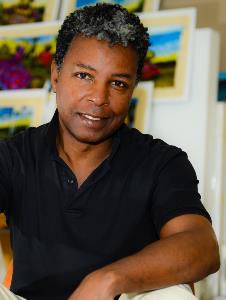Claflin to Host Exhibit and Lecture by Renowned Artist Jonathan Green
Sep 02, 2015
 Jonathan Green
Jonathan Green has achieved international renown as an artist. But he is also a historian who uses his immense artistic talents to tell the compelling story about African-Americans and South Carolina’s Rice Culture.
In 2012, Green founded the Lowcountry Rice Culture Project, which builds partnerships to explore, reveal, and reclaim the shared cultural inheritance of the Lowcountry rice industry.
The project emphasizes examining the consequences of history and the meaning of heritage as a launching point for broad discussions of race, class, art, trade, history, and economics.
“Rice is really the building block of the American civilization and culture going as far back as the 1600s,” said Green. “The Rice Culture is about the contributions of African-Americans in building this country. “It’s a shame we don’t hear more about it even at HBCUs (Historically Black Colleges/Universities) which benefited from the economic prosperity of plantation owners who helped to build those institutions.”
Green’s collection of lithographs and silk screen prints are currently on display at Claflin University in an exhibit that will run from September 1 - October 2 in the Arthur Rose Museum. The museum is open Monday – Friday from 9 a.m. – 5 p.m. Admission is free and open to the public. Green will visit Claflin on September 24 for a series of lectures with high school and college art students.
“Jonathan Green has an insightful, global perspective of art, history and culture,” said Dr. Henry N. Tisdale, president of Claflin University. “He is a highly-respected, transformative and visionary leader through his art and his humanitarian contributions.”
Born in Gardens Corner, S.C., Green graduated from The School of the Art Institute of Chicago in 1982. Noted art critics and reviewers consider him one of the most important painters of the southern experience. Green’s work, which has been exhibited in major venues nationally and internationally, reflects an intrinsic sense of history and place.
Green’s art has been incorporated into productions of ballet, music, theatre, literature, film, and video documentaries. Currently, Green resides and paints in his studio located in Charleston’s island town of Daniel Island, South Carolina.
“My interest in the rice culture intersected with my desire to be an artist,” said Green. “I learned to draw and paint when I was very young. My art reflects my interest in subjects that I know. I have studied history, politics, agriculture, and economics – none of what we have accomplished as a civilization would be here today without rice – which made this region the Silicon Valley of its day.”
Green travels extensively and his collections have been featured in exhibits throughout North America, Europe, Central and South America, Caribbean, Africa, and Japan. His mastery of color and skillful use of the human figure in rural and urban environments allows him to preserve and share with the viewer a deep sense of community, and how the life challenges of work, love, and belonging are met.
“My themes are universal,” said Green. “Everyone can relate to family relationships, doing the laundry, dancing, church themes, funeral themes, or walking on the marshes and the beautiful landscapes in South Carolina. Most people can relate to my paintings. I’ve been painting for more than 40 years and I have enough subject matter to last me 10 lifetimes.”
Green has received numerous honors and awards for art, social, civic, academic, and cultural contributions. Some of his numerous academic awards include: Honorary Doctor of Fine Arts Degrees (University of South Carolina; The Coastal Carolina University; Sewanee – The University of the South). Other awards include The Elizabeth O’Neill Verner Award for Life Time Achievement; Key of Life Award --- NAACP Image Award; Century of Achievement in Art Award (The Museum of Americas); Order of the Palmetto Civilian Award; and The History Makers Award in Fine Arts, The History Makers National Archives (Chicago, IL).
Some of his extensive humanitarian and civic contributions have helped Diabetic research at the Medical University of South Carolina in Charleston, Sickle Cell Anemia research Mount Sinai Hospital in New York and medical outreach services in Beaufort County, South Carolina. When not painting he uses his networking skills to serve on the International African American Museum and Gilliard Auditorium boards in Charleston, South Carolina, and many cultural and civic advisory committees throughout the south.
As an African-American artist, Green is sensitive to the difficulties many of his colleagues face while trying to achieve his level of success.
“It’s very difficult if the support is not there, especially from the African-American community,” said Green. “HBCUs, churches and other organizations that are influential in the African-American community should invest in art that depicts images that reflect our experiences and our communities.”